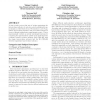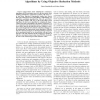44 search results - page 1 / 9 » The logarithmic hypervolume indicator |
146
click to vote
FOGA
2011
14 years 4 months ago
2011
It was recently proven that sets of points maximizing the hypervolume indicator do not give a good multiplicative approximation of the Pareto front. We introduce a new “logarith...
104
Voted
EMO
2006
Springer
15 years 4 months ago
2006
Springer
The design of quality measures for approximations of the Pareto-optimal set is of high importance not only for the performance assessment, but also for the construction of multiobj...
116
Voted
PPSN
2010
Springer
14 years 11 months ago
2010
Springer
The hypervolume indicator is widely used to guide the search and to evaluate the performance of evolutionary multi-objective optimization algorithms. It measures the volume of the ...
88
Voted
CEC
2007
IEEE
15 years 7 months ago
2007
IEEE
— Hypervolume based multiobjective evolutionary algorithms (MOEA) nowadays seem to be the first choice when handling multiobjective optimization problems with many, i.e., at lea...
111
Voted
GECCO
2010
Springer
15 years 5 months ago
2010
Springer
In order to allow a comparison of (otherwise incomparable) sets, many evolutionary multiobjective optimizers use indicator functions to guide the search and to evaluate the perfor...


